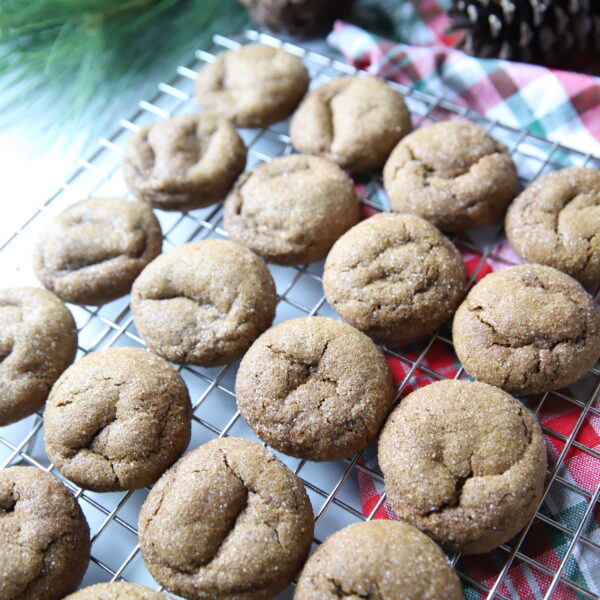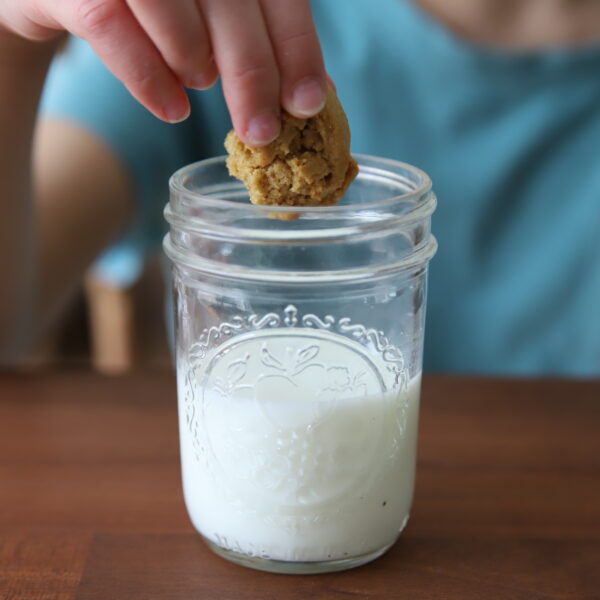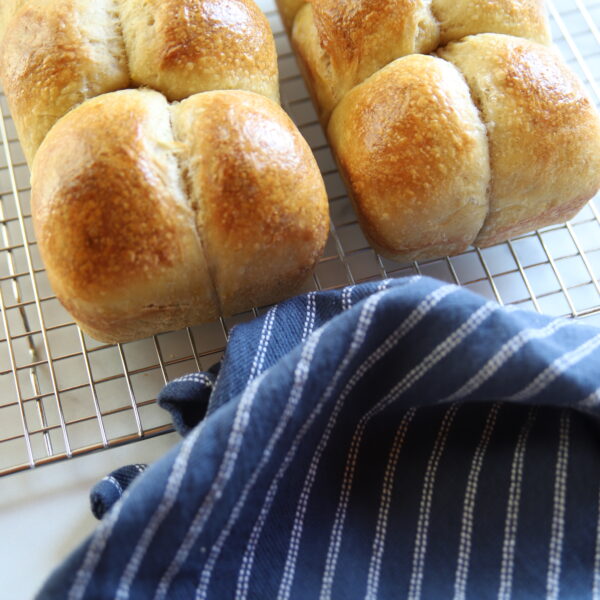“Back to Basics” is a new weekly series that focuses on preparedness and simple practical life skills to help inspire you on your natural living journey.

It seems like I have been spending a lot more time in the kitchen these days; which in reality, is not that uncommon in the hollow. (smile) Believe it or not, I love it! Prior to making a few simple changes in our kitchen, it was a bit like working in a dark dungeon. We have a porch that wraps around the front and side of our farmhouse that unfortunately blocks a lot of the natural light coming from the outdoors. We are all about keeping it simple and using what we have to make our homestead better on a budget. Having simple, organized areas makes it easier to cultivate beautiful and functional spaces in our farmhouse.
I get a lot of questions about our baking from scratch and especially questions on the benefits of sourdough and how to get started. If you haven’t read my post on starting wild sourdough at home you can read it here. Today, I want to talk to you about rethinking the health benefits of quality whole grains.

We have this plaque sitting on our butcher block counter in our pantry. It has been with us through years of military moves. It served as a great daily reminder of just how important Jesus is and how much we need Him in our lives each and every day. It doesn’t take a seminary degree or the perfect bible translation to understand why Jesus used this hyperbole. Without food and without water, we would cease to exist. Period. Plain and simple.
John 6:35
Jesus says I am the bread of life he who comes to me will never go hungry,
and he who believes in me will never be thirsty.
SO WHAT CHANGED?
As I continued to look at the plaque over the years, it hit me. Over the last few decades, there has been a major shift in the amount of processed grains that Americans consume each year. Our processed sugar intake ranks right up there with our grain consumption. The government subsidies for wheat, soy, and corn seem to have had an impact in seeing more of these ingredients in more products on the grocery shelves. Unfortunately with that rise, there has been an influx in the diseases related to GI , blood sugar balance, and chronic inflammation issues. Could there be a reason behind this rise? You betcha! Stay with me here. Something else that stood out to me was, how could bread (moreover the grain that bread is made from) be bad if Jesus himself used it as an example of how important He is in our life? Without Him, there would be no life, after all. So if He used it to describe Himself in the simplest of life-giving terms, then how could it be bad?
Well, it wasn’t “bad” or compromised until around the 1800s when the milling process started to change. This marked the start of the process of how to quickly separate the bran and the germ from the endosperm to help extend the shelf life and prevent the flour from going rancid faster. By separating the important parts of the grain, the less nutrition the end product becomes.

We have started buying our grains in bulk from a local family-owned market and milling it with our Nutrimill Grain Mill which is back in stock.

It took me a while to find the right grain mill and when I was ready to take the leap, they were literally all “out of stock” online. I checked all the shops on line until I found that one shop that had a few left in stock. Not sure if the shortage was due to the pandemic situation or not, but if you are in the market, you can order them on Amazon here.
**This post may contain affiliate links. Read my full disclosure here.
WHOLE GRAIN IS MADE UP OF 3 PARTS-
Bran– the outer shell that protects the seed, is rich in fiber, and offers trace minerals, and B vitamins
Germ– is the inner layer, rich in nutrients like antioxidants, vitamin E, B vitamins, and where the healthy fats are stored
Endosperm– is the bulk of the kernel that provides vitamins, minerals, and carbohydrates and proteins that help provide energy
NOTE: In order to receive the benefits from whole grains, all three parts of the grain must be present. Grains, seeds, and beans contain phytic acid which is an anti-nutrient that helps protect the seed from spoiling too quickly. Unfortunately, it also bonds to certain vital nutrients and vitamins, blocking their absorption. It also prevents proper digestion and can cause nutrient deficiencies when too much is consumed on a regular basis. Sprouting, soaking, and fermenting help to breakdown the phytic acid present, making it easier to digest.

Unsplash
ONLY PART OF THE PROBLEM
The change in the milling process is only part of the problem. When you add in high fructose corn syrup, artificial preservatives, flavors, coloring, and other artificial ingredients, you’re left with products that are low in nutrients and high in other things that you don’t want. Don’t forget to add the fact that our grains have been hybridized, genetically modified, and sprayed with chemicals that have been shown to disrupt our endocrine system and cause cancer. From planting, to harvesting, to consuming, it all factors into whether or not the end product will be beneficial to our health or damaging over time.
As you can imagine, due to all these changes over the years, it has changed its original design. Prior to having store-bought yeast, families made their own wild yeast starters at home. They would grow their own gardens. Preserve their own harvest. They would mill their own grains. They would wait for their dough to rise and then they would bake their bread daily. They would do this process for generations until mass production and convenience stepped onto the grocery store shelves to make things “easier.” Natural whole foods were replaced with overly processed, “vitamin enriched” boxed “foods” that had longer shelf lives. Faster does not always mean better. Convenient does not always mean better…or healthier for that matter.

GETTING TO THE ROOT
If you are trying to stay away from bread or are restricted from gluten, I highly recommend doing a little bit of extra research. Especially on the ingredients that are being used to replace these foods. Sometimes, they may be more harmful than helpful. A lot of people are finding that they are gaining weight on these convenient GF (gluten free) products due to the fact that the ingredients used contain things like tapioca starch, potato starch, rice flour etc…which are higher on the glycemic index. You may be preventing yourself from gluten exposure and flare ups, but you may be adding to the fire which can cause other symptoms to manifest in the long run. Learn more simple facts about going gluten free here.
When you have issues with your gut, you do not want to just remove the triggers and call it good. You want to naturally be able to strengthen your gut health by building up your gut flora. You want to be able to strengthen the gut lining and in turn naturally boost your immunity and decrease chronic inflammatory responses. I can tell you that it is not going to be from a shot, surgery, or a magic overnight pill.

Einkorn dinner rolls (ancient grains tend to have less gluten)
ADDRESSING THE ISSUE
Changes in our food and lifestyle choices can go a long way. REAL Food is medicine and naturally building your health back up takes time. Small steps toward healthier and mindful living will be easier to maintain than making restrictions that are challenging to sustain long-term. If baking from scratch does not appeal to you, look for organic sprouted grain bread in the stores. We keep some “Food for Life” Ezekiel 4:9 loaves and English muffins (try my homemade sourdough English muffin recipe here) in our deep freezer for when we need a break from baking. Simple Truth brand also offers a lighter sprouted grain loaf that our littles enjoy.
Some folks have found that when they are visiting in Europe, they are able to eat fresh baked bread with no flare ups. There are many ideas online explaining possible reasons for that. People are on vacation and more relaxed when overseas. The food in Europe is made with fresher ingredients. The bread is made fresh daily with fewer processed ingredients and shorter shelf life. Some articles point out that Europe is known to purchase flour grown from the U.S. and that European wheat has also gone through the hybridization process over the years, but that still doesn’t explain the difference in a lower gluten content. About 10% lower. Whether Europe’s wheat crops use fewer pesticides, less processed ingredients, or fresher ingredients, the answer may lie in the process in which the bread is made daily and for how long the dough is allowed to ferment. Which as previously mentioned, helps to partially break down the gluten and lactic acid. Therefore, making its consumption more tolerable. Especially for those dealing with gluten intolerance or sensitivities.
Many folks think that they just don’t have time to start their own sourdough and bake their own bread. And that’s ok. Sometimes, just a little shift in our priorities and trying something out can give us the confidence we lack when we are just starting out. Honestly even with the extra preparation, the peace of mind you have when you are giving your family the best food options available can make all the difference in your lives today, as well as your health in the future. Remember, disease typically doesn’t show up overnight. More often than not, it is a cumulative effect that begins years before your first diagnosis. We have to build our foundation from the ground up. Even those with predisposed issues can still find natural health benefits from making wiser choices.
THE PAY OFF
By going back to basics and with a little preparation, you can really unlock the health benefits whole-grain homemade bread offers. This goes beyond more than just fiber and protein. It offers a variety of phytochemicals, antioxidants, healthy fats, and essential vitamins and minerals the body needs.

Cast iron sourdough chicken and spinach pesto pizza. Check out my “secret” to making perfect homemade sourdough pizza here.
Curious about cast iron cooking? Check out my simple tips on how to get started here.
YOU CAN’T RUSH A GOOD THING
To start making healthier bread at home, you will need a sourdough starter. Learn how to make your own starter here. Not all sourdough is equal. Store-bought sourdough uses commercial yeast and other ingredients to get a faster rise. Homemade sourdough comes from bacteria and yeast from the air. Wild yeast is living. Think of it as a pet or plant. It needs to be fed and watered. As it grows, it will develop its own little temperament. Overtime, you will begin to see what your sourdough likes and what it doesn’t. Little adjustments as you get to know each other better, helps to give you the best results in your baking.
Having your own starter in a small way helps you become less dependent on products from the grocery store, which in times of crisis like these, people are finding themselves out of basic necessities like flour, yeast, and toilet paper. All joking aside. Staying on top of preparedness for your family is no laughing matter. It is better to be safe than sorry in the long run and you get the more important benefit of helping to naturally support your family’s overall health, so that you are more able to do God’s will. And hopefully be better prepared for any challenges or emergencies that may arise in the future.
This is a perfect time to get back to basics and start learning some of these practical life skills that have helped generations before us prosper and thrive. Being better prepared or more self-sufficient doesn’t require a large plot of land, or all the farm animals, or making everything from scratch. You can start right now. Making the transition to natural living is a process. Enjoy the journey and start today.

Disclaimer: The health and wellness posts shared here on GracefullyHome.com are not intended to diagnose, treat, prevent or cure any illness or disease. The information provided on this blog is for general educational purposes, has not been reviewed nor approved by the FDA and is not intended to take the place of advice from your medical professional, licensed dietician or nutritionist.
You are solely responsible for your health care and activity choices. Use of any of the recommendations or helpful tools and tips on the GracefullyHome.com blog does not constitute a client-coach relationship.




Leave a Reply